Thymen refers to the category of those plants that will not only decorate your plot, but also can be used in cooking, medicine. Thyme is also called the chamber. He can act as a beautiful soil plate, which will give the charming aroma of every man passing by him. In this article, we consider ways to cultivate the vocabulary on the site, the peculiarities of care for him, we learn about the beneficial properties of thyme.
Thyme. Description of the plant and its features
- Thymes in the people can be called a chamber, lemon, Mukhopal, Gadobnik, Versest, Borovy Pepper, Bogorodskaya Grab, Chebarca.
- Thymeyan belongs to the family of Clanotkov.
- Thymen is common in Eurasia, North America, Greenland.
- Thyme may grow in vivo in a variety of places, depending on the variety. Thyme varieties can be found in forests, in glades, on stony slopes, in the steppe.
- Thyme can reach a height of 35 cm.
- Thyme - a semi-stabilizer plant or a low shrub.
- Stems in Tymeyana are weed and ascending, lying or ascending.
- The root system of thyme is represented by a rod root, which is also unreserved.
- The leaves in thyme may have a different form depending on the variety. They can be sedentary or grow on short stiffs. The form of them can be both oval, rounded and more oblong. Leaves are very rigid, dense, leathery.
- Tymeyan flowers are collected in oblong inflorescences. They can be white, pink, purple color. Most often it is the purple shade. Thyme flowers are very fragrant, that, of course, attracts a large number of insects.
- The period of active bloom of thyme can continue all summer months.
- At the end of summer, thyme ripens the fruit - a box with 4 nuts.
Thyme. Facts from history
If you are going to grow in your area fragrant thyme, then you may be interested in his rich history. It turns out that this plant came to us from the distant antiquity. You can find the following interesting historical facts about the use of thyme:
- the most ancient mention of Thymene belongs to the III millennium BC. Sumerians, one of the most ancient civilizations, left behind the mention of thyme on the clinp signs. They used this plant for a variety of healing seizures and a rocker, the recipes of which were written on the signs;
- in ancient Egypt, Thymeyan was considered the plant of God of Serapis, who was God fertility and health. Ancient healers used this fragrant plant for mummification, for the treatment of paralysis and other serious diseases;
- in ancient Greece, Timyan was considered a plant of Aphrodite. It was this plant that would fit in the temples at the time of sacrifice. Also, the Greeks believed in the legend that thyme rose on the site of spilled tears Elena beautiful;
- in ancient Greece, it was also accepted to take baths with thyme. It was especially recommended to make it warriors to give them more courage and courage;
- in ancient Greece, there was a massage with Timyan oil, used it in recipes for the treatment of memory disorders, meningitis. Thyme also attributed to the means, which perfectly helps with fainting;
- in ancient Rome, Timyan was associated with God Saturn. This plant was widely used in folk medicine. With it, they prepared funds against worms, for the treatment of diseases of female organs. A beverage from thyme was useful to be given during childbirth, as well as in the treatment of asthma and other diseases of the respiratory system;
- mention of Thyme can be found even in the Bible. Jesus himself was born by the Virgin Maria on the litter of Thyme;
- at the time of the Middle Ages, the thyme was considered a symbol of courage and courage. The knights decorated themselves with embroidery with the image of this plant, took with them the dried twigs of thyme, drank a drink from this plant;
- in many European countries, there were beliefs in the mystical nature of Timyan. People believed that fabulous fairies sleep on the bedding from Thimyan. And in order to see these magical creatures, it was necessary to wipe the eyes of the dew, assembled from this plant;
- there was belief that the poisonous snakes will leave their lair from the smoke of the burned thyme;
- a good admission for fishermen was considered fumigation of thyme fishing gear before fishing. After such a rite of catch was to be rich;
- another interesting admission, which moved and in modernity, was the use of thyme to stinging the pillows. Sleep on such a fragrant pillow should be especially sweet and strong;
- in ancient Russia, Thymes most often called Bogorodskaya grass. This name plant received due to the fact that the icons on the feast of the Assumption of the Virgin are decorated with bunches of this grass;
- in ancient Russia, Thyme also attached a magic meaning. It was often used in pagan rites, they did the heraggie from evil spirits, the unclean;
- in Russia, it was very important to have a bouquet of thyme in the house. It was believed that this plant retains youth, helps a woman to endure a child, creates a good aura in the house. Women soapped hair with a decoction from the thyme, decorated themselves with wreaths of this fiantly aroma of the plant.
Thyme. Beneficial features
In order to start talking about the beneficial properties of thyme, you need to find out what kind of valuable chemical composition it possesses. And you can find in it the following useful elements:
- group vitamins in;
- tannins;
- vitamin C;
- gum;
- apple acid;
- acetic acid;
- oleic acid;
- ursol acid;
- fats;
- resin;
- essential oil;
- flavonoids;
- minerals.
As you can see, the chemical composition of thyme is really impressive. If you grow this plant on your site, you can use it as a "national doctor." Thyme showed its effectiveness in the folk treatment of many diseases. This plant can be used by people to provide various effects:
- thyme is known as a natural vegetative agent with an anesthetic effect. That is why it can often be found in folk recipes for the treatment of neuralgia, Malgia, pinching nerve, etc.;
- the expectorant effect of Tymean is also worthy of respect. You can use the ointment based on the thyme for the trituration of the chest and the back during colds and ORVI. Infusions, decoctions and teas from thyme are useful to use with various diseases of the respiratory system - bronchitis, pneumonia, with bronchial asthma. Thyme contributes to wet wet and improves its flipping;
- help in the treatment of diseases of the nervous system. It is useful to use tea, champs and chasters from Thimyan to people suffering from problems with sleep, disorders of the nervous system, emotional overvoltage;
- thyme is also known as natural remedy against worms. Such an effect is achieved due to the content of thymol in it;
- treatment of diseases of the gastrointestinal tract is also possible with thyme. It helps to reduce the scrawl, getting rid of the meteorism, helps digestive processes;
- thyme - Natural Antiseptic. This plant is often used to treat various skin diseases;
- thyme - a famous assistant in delivering unpleasant sensations after the bite of bees;
- thyme has proven its effectiveness and treatment of male diseases. It helps increase potency, performs excellent prevention of prostatitis;
- women suffering from disorders of the menstrual cycle should also draw their attention to the recipes of traditional medicine with thyme in the composition. Predated this plant was used in the process of childbirth in order to strengthen generic activities;
- thyme has a positive effect to people who suffer from an increase in blood pressure. Plants gently and naturally expands the vessels, thereby lowering the pressure.
Thyme - a truly universal plant, which can be a real natural "first aid kit" on your site. Of course, you should not forget that any treatment of herbs must be coordinated with the doctor. Hope to cure a persistent arterial hypertension or any other illness alone is not only Thyme. Do not eat this plant if you have its individual intolerance, a tendency to allergic reactions from medicinal herbs. Forget about the treatment of children under 6 years of herbal medicine recipes.
Thyme. Photo
Tyme and types
Timyan ordinary
The homeland of this variety of thyme is considered the Mediterranean. It has shoots up to 15 cm long, and the plant itself can reach 20-30 cm in height. The leaves have a small size, slightly pubes in the opposite side. Color painting - pale lite or snow-white. The active flowering period begins at the beginning of summer and ends in about august. A variety is not distinguished by increased winter hardiness. If the plant is not covered in a honest and harsh winter, it may be damaged. Thyme ordinary is highly valued for its medicinal properties. Among the popular varieties can be allocated as follows:
- "ALBA";
- "SPLENDENS";
- "Coccineus".
Timyan Creeping
Pretty popular Timyan variety among summer residents. Thymeyan creeping in the photo looks quite effectively and can be used as a "substitute" of lawn, it grows well with a dense carpet, which is decorated with small and fragrant colors. Thyme creeping in care is unpretentious. Flowers can be white, pink, lilac, lilac. It is this kind of thyme in Russia that was called a chamber or a Bogorodskaya traveler. The plant is perennial, reaches a height of 15 cm. Its creeping stalks are intertwined with each other. For thyme of Czczuppost landing is possible even on stony slopes. Among the well-known decorative forms of Timyan, the following can be distinguished:
- "Donna Valle";
- "Kolkhida";
- "Silver Queen."
Timyan Limonnophang
Timyan Limonnopharyncing is a perennial hybrid plant that is widespread in southern France. Thymeyan reaches a height of 30 cm, and in order for the shrub to look decoratively, it constantly needs to be cut. A feature of this variety is a special fragrance that resembles the aroma of lemon. Leaves have a spectacular pest in color and rounded shape. Blossom comes in the middle of summer. The disadvantage of this type is that it poorly reacts to sudden temperature differences and at low temperatures as a whole. Popular varieties of thyme lemon-making:
- "Golden Duarf";
- "Golden King";
- Silver Quen.
Thyme Bloshina
This type of thyme can often be found at the roasolines of roads, on rocky slopes, in the mountainous area. Flowers have a pleasant pinkish shade. Stems lying, can reach 15 cm long. The phase of active flowering in Tymeyan flea is coming in the middle of summer. This type of thyme is highly valued for its medicinal properties.
Timyan Dorfler
This type of thyme can be found not so often. In natural nature, it is found in the Balkans. This perennial grows up to 10 cm, has miniature flowers of dusty pink shade. The disadvantage of this type of thyme is its poor tolerability of cold. He prefers to grow at sunny places that are well protected from the wind.
Thyme Subarctic
Subarctic thyme in natural nature is found in forestry arrays of Eastern Europe. The stalks of this perennial semi-staples are weird. The flowers of the tender purple shade have the shape of the bell tip and are collected in inflorescences. A distinctive feature of thyme subarctic is a rich content in it of essential oils. Oils not only give the plant a delightful aroma, but also make it valuable raw materials in the recipes of traditional medicine.
Thyme early
This spectacular perennial came to us from Turkey, the Caucasus. It belongs to the family of Clanotkov, as well as the other types of thyme. The plant reaches a height of 7.5 cm to 15 cm. Prefers to grow on well-lit, well-drained soils, poorly tolerate the mooring of the soil. A feature of thyme early, which can be guessing from the name of the species, is its previous blooming. But it is not so long to enjoy spectacular colors.
Thyme. Growing
Step 1. Choose a place to land the thyme in the open soil
How to grow thyme? In order for Thymeen to feel as comfortable as possible on your site, take care of choosing a good place to land. The plot must meet the following requirements:
- the plot should be sunny;
- the plot should be dry;
- the plot must be well purified from weeds.
timyan negatively refers to too shady places, it will be intensively stretching up, not giving beautiful flowering and fragrance. Also this plant does not like humidity. Too wet should not be both soil and air.
Step 2. Select the soil for the landing of thyme
Ideal for thyme soil is a soil with neutral or alkaline soil. If your site is distinguished too heavy and clay soil, then definitely get the time to create a good drainage. Choose light, fertile soil.
Step 3. When to plant thyme
Due to the fact that thyme is a frost-resistant perennial, it can be planted as in spring and autumn. Autumn should not be late, as the plant must have time to root well. Most of the grades of thyme do not require any shelter in winter. But in a honest and very harsh winter it is better to cover the plant with a sweet plant or other sheltering material.
Step 3. Landing thyme by seed method
After you chose a place on your site, suitable for the landing of thyme, you can start landing. Most gardeners prefer to grow thyme with seed sowing. They can be sown immediately into open soil, or grow seedlings at home, and then transplant it to the permanent site.
- The plot of land before sowing seeds of thyme no need to loosen too deep, since the root system of this plant is superficial, does not go deep into the ground. Clean the site from weeds thoroughly.
- Preparing a plot to landing thyme can be in advance. If you are planning a spring landing, then autumn after the surpasses of the bed is made there Mineral and organic fertilizers, manure or compost. In the spring, reap the garden again and bring urea in the calculation of 20 grams per 1 sq.m.
- Not too blocking landing material in the ground, plant seeds on a prepared area.
- The approximate distance between the rows is 40 cm.
- Seeds slightly sprinkle on top of the river sand layer 1 cm.
- After the seeds are good, you need to follow the humidity of the upper layer of the soil, not allowing it to dry. It is also important to ensure that weeds do not appear, which can harm the further growth of young seedlings.
- After the seedlings germinate slightly, ride crops, leaving about 30 cm between plants in a row.
If you planted seeds at home, so that in the open ground then planted grown plants, then support the temperature of the air to do not make the plants "greenhouse" and not adapted to the street conditions of growth. Timyan's crops for growing seedlings can be produced in the second half of March. Seeds also do not plunge, but sprinkled with sand. At the age of 70 days, seedlings can be transferred to open ground. If you sew thyme in the soil immediately, then shoots will appear in about 2 weeks, but under the condition of ambient temperature - 20 degrees.
Other methods of breeding thyme
Tyme reproduction by drawing
One of the easiest and most effective methods of breeding thyme. You need to cut off the green escape from an adult plant and put it in the ground. For better rooting, experienced gardeners are recommended to cover the cuttings with a can and water it around the jar. In this way of watering, you will avail the soil moistening and provide thyme greenhouse conditions that will help him quickly form their own roots. If you want to multiply a completely low-minded thyme with fluttering shoots, choose a stalk with a height of no more than 5 cm. A huge advantage of such a method of breeding thyme is the ability to plant cuttings at any time of the growing season.
Timyan breeding division bush
The division of the bush is another simple and very effective way of breeding thyme, which allows not only to get a new plant, but also rejuvenate a bush.
- Carefully dig a bush.
- Prepare a place to land a new plant.
- Divide the bush on as many parts, as much as its size allows.
- Spare parts of the bush for permanent growth places.
Thyme. Care
With the cultivation of thyme, even a beginner in the horticultural business will perfectly cope. This perennial plant is absolutely unpretentious to care and grow it - only pleasure. A huge advantage of this medicinal plant on the site is its excellent resistance to diseases and pests. You can note some important points that you still have to draw your attention if thyme is growing on your site:
- early spring or after the end of the flowering period, cut the bushes of thyme to the weird part of it. After such a pruning procedure, the bushes will grow more lush and compact;
- thyme - a plant drought-resistant. But in too long drought, it is still worth pouring it;
- thyme - a plant that negatively refers to weeds, like any other decorative plant in the garden. It is especially important to carefully pour a bed with thyme from weeds at the first time when plants are just beginning to develop. The root system of thyme is superficial and can be easily damaged by adjacent weeds with a too active and powerful root system. In addition, your girling with a fragrant chamber will lose its decorativeness if it touches weed herb;
- thyme has grown perfectly and develops without fertilizer. Only those plants that are already growing for over 2 years, it is not superfluous to be a feeding of mineral and organic fertilizers, the infusion of a cowboy. Do not make fresh manure, as the plant does not like him.
If you grow thyme with the goal of its workpiece, then you can collect his crop during flowering. Carefully, without damaging the bush himself, cut the well-limiting shoots. Thyme can be dried, and then grind. It can also be used in fresh form.
Thyme at home
Thyme in a pot. Rules for growing on the windowsill
If you do not have a nice site, but you dream about fresh greenery, Timyan is a wonderful choice for growing on the windowsill. This plant will not only harmoniously fit into any interior, but will make it possible for year-round access to fresh olive spices, to the medicinal plant, to the care means. Let's consider the order of your actions when growing thyme in a pot:
- choose a beautiful pot or any other capacitance high no more than 15 cm;
- fill the pot with nutrient soil. You can use the soil "for cacti" and add a little black soil to it. At the bottom, be sure to put the drainage layer;
- timyan seeds simply decompose on the surface of the wet soil and pour the soil with a layer of about 1 cm;
- with the help of a spray gun, moisturize the soil surface;
- until the appearance of shoots, you should not keep a pot on a sunny place. It may turn searches;
- first sprouts you will notice after 10-20 days.
It is possible to grow thyme on the windowsill, not only from seeds, but also with a cutting. From an adult plant, whose flowering period has already ended, cut the escape. Free his lower part from the leaves and plant a plant in a pot. Water it moderately until the appearance of new leaves. Then watering is reduced to a minimum.
Timyan care on the windowsill
- Make sure that the windowsill was constantly warm and sunny.
- Do not dwell with watering. Remember that thyme in wildlife grows on stony slopes.
- Cut the twigs at thyme, which grows on the windowsill, you can at any time of the year. But do not too much, cut off every time with a new plant.
- Loose soil, but not too deep. The root system of thyme is close to the surface of the soil.
Give yourself a pleasure in contemplation on your site of a beautiful and incredible valuable plant - Thyme. Caring for this perennial will not give you any trouble. Successes in growing!

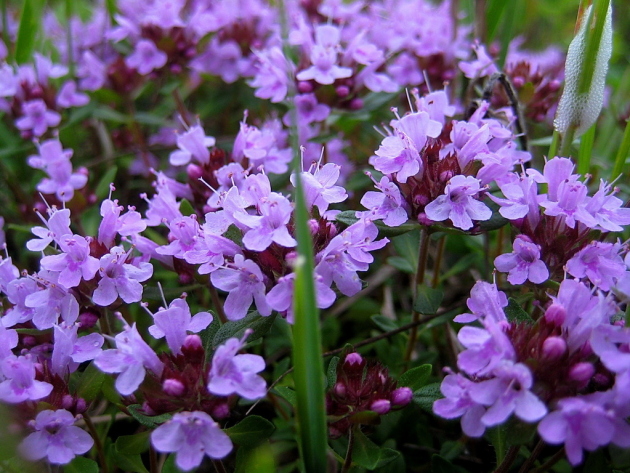
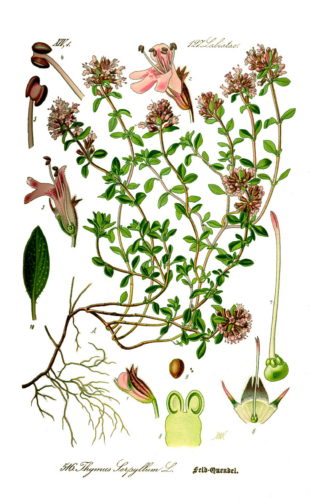
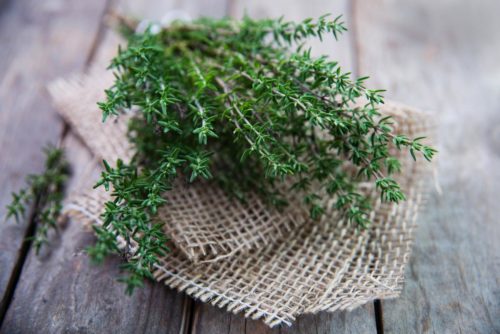
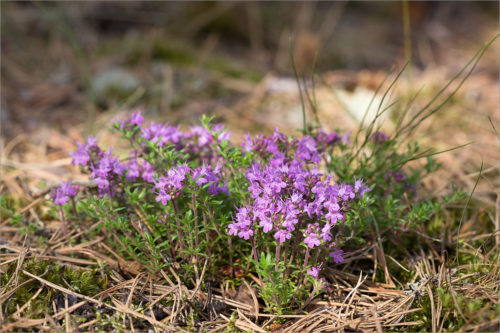
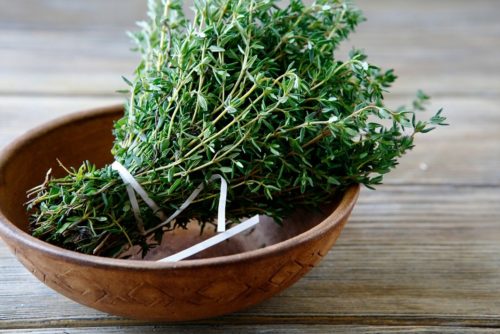
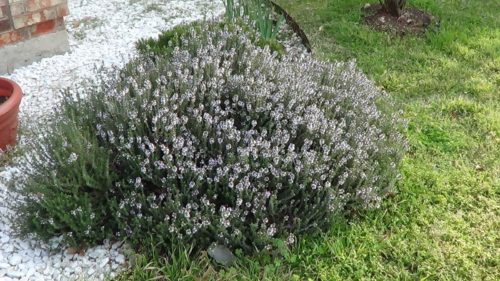
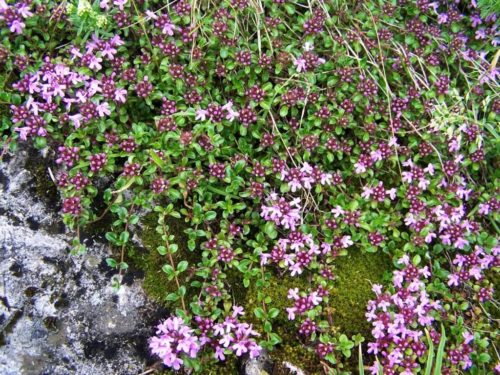
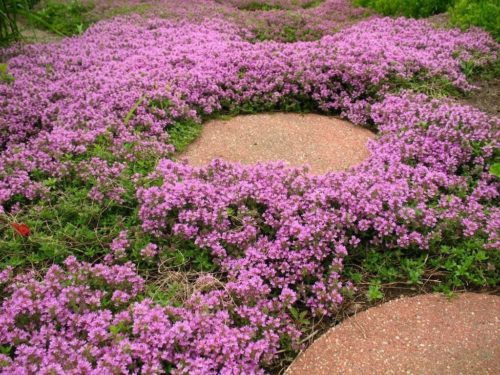
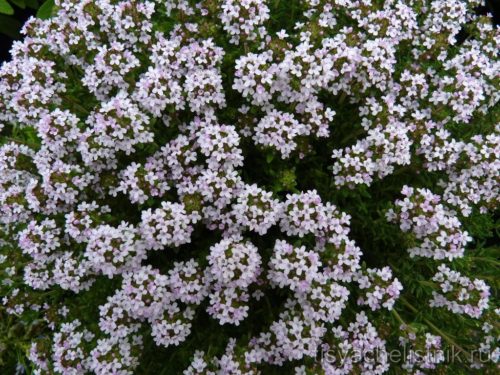
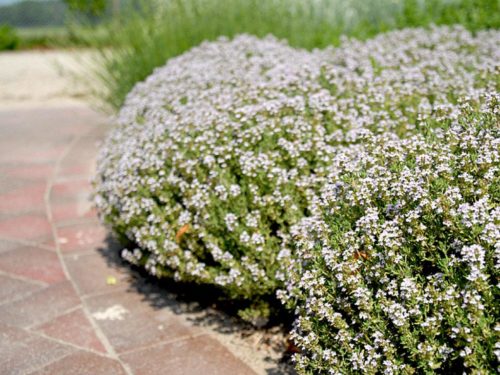
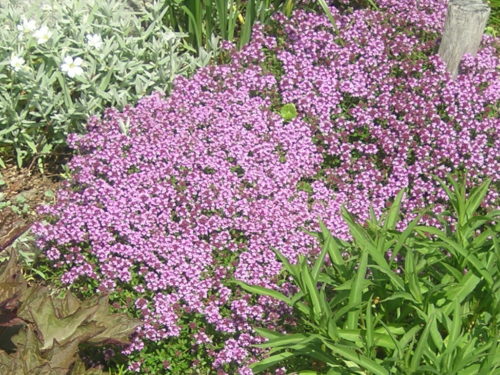
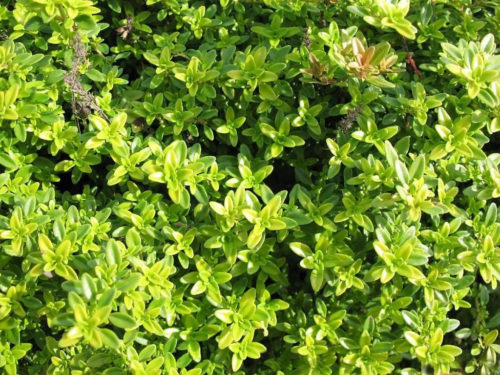
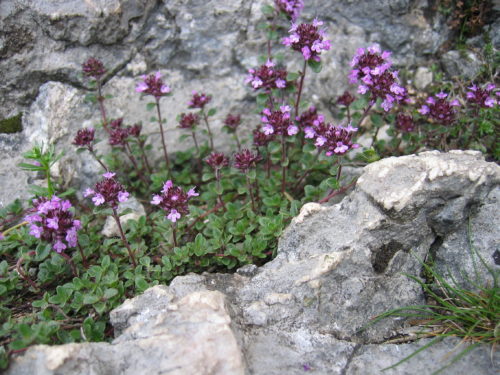
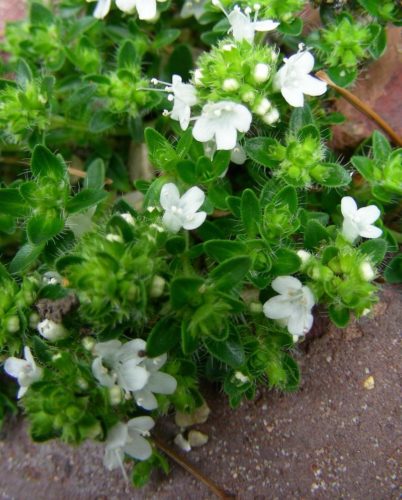
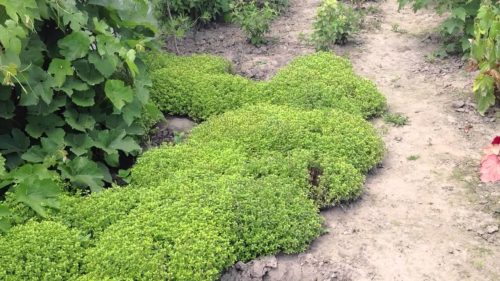
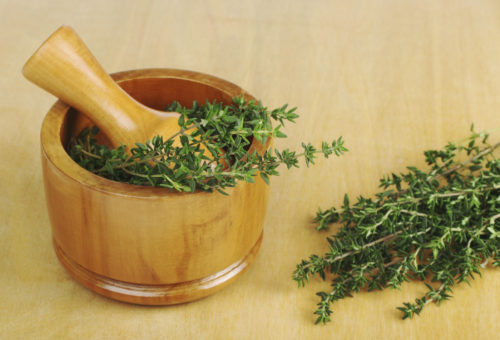













 Start a discussion ...
Start a discussion ...